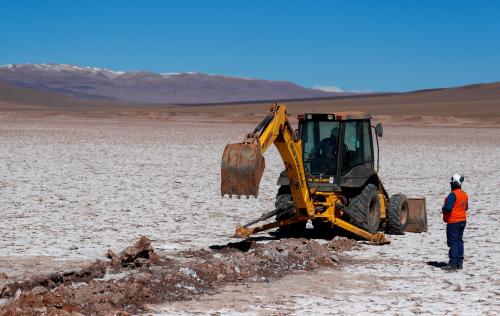Content from the Brookings Institution India Center is now archived. After seven years of an impactful partnership, as of September 11, 2020, Brookings India is now the Centre for Social and Economic Progress, an independent public policy institution based in India.
Does India have ‘too much’ electricity capacity? Every electricity grid operates in a balance between supply and demand, usually with a slight surplus of capacity to meet eventualities and uncertainty—too much surplus becomes expensive. Surplus has two sides: either the demand is lower than projected, or supply is higher than required in equilibrium. However, it is critical to differentiate between surplus capacity (measured in kilowatts or gigawatts) and surplus energy (measured in kilowatt-hours or “units”). One can easily have surplus energy on average without having surplus capacity all the time—there may be periods of surplus capacity at some times of day or locations. Renewable Energy (RE) creates particularly acute issues for the grid since it is both variable as well as likely available only at specific times.
India’s gross electricity capacity is much higher than the demand. For decades, India faced chronic shortfalls of power, manifesting as load-shedding and unmet demand. For a change, shortfalls have fallen dramatically and there is talk of “surplus” power. Official data say chronic shortfall of power fell to 0.7 per cent on an energy basis in 2016-17—a remarkable achievement—with forecasts of a surplus in 2018. So why is there still load-shedding? There is a methodological flaw with how shortfalls are calculated, but more importantly, load-shedding is often an economic issue where state utilities (the distribution companies, or DisComs) are not buying sufficient power because they are cash strapped and bleeding money.
Even though RE, specifically wind and solar, has zero marginal costs (use it or lose it), sometimes other plants cannot be backed down quickly enough, or must operate at a minimum level. This means curtailing (throwing away) RE.
Not only is renewable energy growing remarkably already—India had the second-highest solar capacity addition in the world in 2017—the targets of 175 gigawatt (GW) by 2022 require an annual growth of well over 25 per cent. This target is top-down, set by the central government, and doesn’t incorporate much (if any) feedback by DisComs on how much power of what type is needed by that year. An additional challenge has been that in recent years (FY 2011-17), coal-based capacity has grown at over 12 per cent annually, double the growth rate of power demand. This creates a lot of overhang that impacts grid economics.
RE makes other supply back down, but eventually may need to be curtailed
Economics aside, at a technical level, “how much RE can the grid handle?” is a complex question that depends heavily on what else is on the grid – RE’s variability inherently needs other sources to act as balancing supply, and the ideal sources (hydro and gas) are constrained in their growth potential in India. At low levels of RE, grid integration is easy, but all RE creates system-level costs, which are often hidden or absorbed by the rest of the ecosystem. A Central Electricity Authority (CEA) study estimates that such costs as of today are almost Rs 1.5/kWh, or more than half of recent RE bids.
Grid operators, specifically, load-despatchers, optimise the grid for economic savings based on technical constraints including which plants can operate when, transmission congestion, etc. Even though RE, specifically wind and solar, has zero marginal costs (use it or lose it), sometimes other plants cannot be backed down quickly enough, or must operate at a minimum level. This means curtailing (throwing away) RE.
The targeted 175 GW of RE is disproportionately concentrated in a handful of states. Karnataka today already has almost 5 GW of solar and more of wind, far ahead of its targets. In contrast, the maximum load served is only about 10.2 GW, and during the monsoon (and thus windy period) demand can fall to some 6.5 GW. The entire systems planning has to shift from one of managing scarcity to managing surplus, at least for parts of the day or year.
The 175 GW of RE planned by 2022 would represent more RE supply than net demand for multiple states, necessitating transmission to other states. As RE further grows, even adding infinite transmission capacity to ship power from anywhere to anywhere won’t help if the national demand is lower than aggregate supply. Either viable storage technologies are required or RE will need to be curtailed. It’s worth mentioning that while one can plan for average levels of transmission or storage or curtailment, variations in demand and grid constraints etc. mean curtailment may be required even at lower-than-theoretical levels. In the long run, a stronger grid, cheap storage, and the ability to shift load to match supply conditions will all help reduce, if not avoid, curtailment. However, any system designed for zero curtailment only is likely to be a higher cost solution than an optimal portfolio design that allows for multiple scenarios and options of dealing with so-called excess supply.
Managing the surplus: Steps to help RE scale
While finance is a key need for growing RE, grid integration is another key pillar required for it to scale. One active area of effort is strengthening RE prediction capabilities, through RE monitoring centres (REMCs). Ultimately, it will have to address the largest challenge, counter-party risk stemming from loss-making DisComs (distribution companies, or utilities). Before we get there, there are three specific steps India can take to help properly plan RE’s growth and its management.
- Mandate capture of data on RE curtailment along with reasons why
Today, there is no aggregation of curtailment information, in part because it can turn commercially contentious. Just like California mandates and publishes curtailment data regularly, all RE curtailment in India should be categorised across two dimensions: technical versus economic, and local versus system/grid-level. (California’s categorisation is more complex, but reflects market conditions that can lead to self-curtailment). If we see the experience from California in 2017, a mature market with excellent grid stability, we find that excess supply regularly pushed wholesale market prices into negative territory, and curtailment, predominantly of solar, was measured in the thousands of megawatts.
Note that curtailment can mostly be operationalised for utility-integrated, grid-scale RE. Rooftop solar is unlikely to become curtailed, and certainly self-use can’t be captured, but it then puts pressure elsewhere as net demand falls.
This step isn’t just an academic accounting exercise, it will have implications for payments. If an RE generator is backed down, contracts in India have historically been set up such that generators don’t get paid for energy not delivered. If they are backed down and don’t deliver for no fault of their own, they should be compensated for this, as draft regulations from MNRE indicate.
- Create frameworks to compensate curtailment
More than just capturing data on curtailment, India needs fair yet efficient frameworks for sharing the burden of curtailment. For coal-based plants, variable costs all vary, so there is an easier mechanism for determining the merit order. With solar plants, all of them have identical (zero) marginal costs.
If one only applied a technical efficiency yardstick to choose which power plant(s) to curtail, based on grid congestion, transmission implications, etc., then it’s entirely possible a small subset would be disproportionately curtailed. In contrast, as Michael Davidson recounts in a talk at Brookings India, in recent years China chose to “spread the pain”. Socialising such costs may be a valid mechanism for minimising the impact on selected plants.
In the long run, a stronger grid, cheap storage, and the ability to shift load to match supply conditions will all help reduce, if not avoid, curtailment.
- Capture and disseminate RE generation data with granularity
Assuming RE is treated as must-run, and is never backed down, it is still important to know how much was actually produced when (and where). This is distinct from the need for tighter predictions. Consumers with rooftop solar and other RE developers want to know what to expect in terms of system performance, which impacts their economics, but the grid really needs to know what is happening not just for economic reasons but for operational ones as well.
While capturing information on rooftop installations is hard, information on larger deployments (aka grid-scale) should be captured into a centralised system. Only recently has CEA started compiling data of aggregate RE production in a month – a step forward, but nowhere near enough. Of course, this same mandate of capturing time-granular production data should apply to all sources of power (with historical data, a dashboard isn’t enough!). If commercial and security reasons prevent plant-level data, then at the least aggregated data should be captured and disseminated.
- Stop treating all units of power the same, i.e., introduce time-of-day (ToD) pricing
Once we revamp our power system operations and policy to meet capacity shortfalls at certain times of day, instead of generic energy shortfalls, the first tool we need is signalling for different grid conditions, especially by times of day. Most Indian power is transacted based on power purchase agreements (PPAs), which treat all power the same, whereas power differs as far as time of day (ToD), predictability, ability to ramp, etc. are concerned. As RE rises, the entire system will need more flexibility, something traditional PPAs don’t offer.
While the transition to more market-oriented systems will take time (not to mention the challenge of how to handle legacy contracts), signalling must vary for different grid conditions to enable the right kind of power. Peaking power, or only operating a few hours a day at most, will inherently be more expensive than baseload coal or opportunistic RE. But we have to enable such power. Such signalling can also drive storage solutions, smart grids, and dynamic load management. E.g., if electric vehicles are coming soon, not only should their demand be spread out and match grid supply conditions (“off peak”), these should ideally match RE’s output periods so they don’t demand more coal.
Ultimately, ToD will have to extend to retail consumers, which will take time and appropriate metering infrastructure. Even here, it’s easier to extend ToD to bulk consumers, who use disproportional power, e.g., in BESCOM (the utility in and around Bengaluru, Karnataka), about 11,000 such high-tension consumers account for almost half the consumption. A starting point remains ToD for power procurement (purchases) by utilities from generators.




Commentary
Embarrassment of riches? The rise of RE in India and steps to manage “surplus” electricity
June 15, 2018